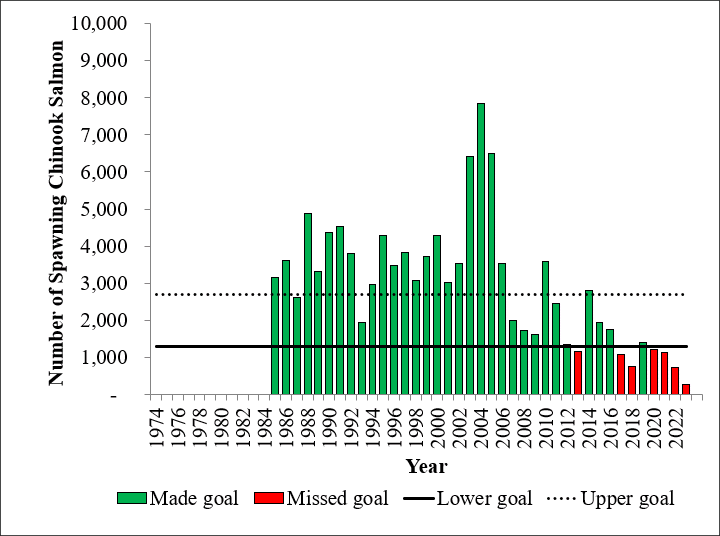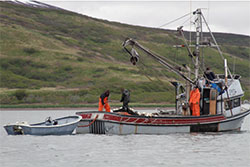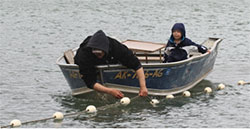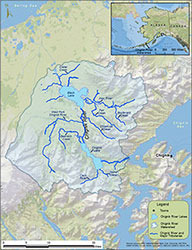Chinook Salmon Research Initiative
Chignik River Chinook Salmon
Chignik River
Overview
There are at least 19 Chinook salmon spawning stocks within the Alaska Department of Fish and Game’s Westward Region which includes the Kodiak archipelago, the north and south sides of the Alaska Peninsula (including Chignik, the Shumagin Islands, and Port Moller), and the Aleutian Islands. The Chignik River is located on the Alaska Peninsula near the village of Chignik and is the largest Chinook salmon producing system on the southern shore of the Alaska Peninsula. The Chignik River watershed is dominated by the Black and Chignik lakes, with the Black and Chignik rivers draining them, respectively. Chignik River Chinook salmon exhibit late run timing, with freshwater entry occurring from late June to mid-August and about half of the run is over by mid-July. Chignik River Chinook salmon are harvested in subsistence, commercial and sport fisheries. A small subsistence fishery takes place inriver and a commercial purse seine fleet harvests Chinook salmon incidental to a directed sockeye salmon fishery. There is also a small sport fishery that takes place in the lower Chignik River.
Adult Spawning Abundance
Assessment of run strength of Chignik River Chinook salmon is conducted with a weir located about halfway between Chignik Lagoon and Chignik Lake. All subsistence and commercial inshore harvests are directly reported and sport harvest is estimated by a survey. Annual run size of Chignik River Chinook salmon is typically around 5,500 fish. Chignik River Chinook salmon have an escapement goal of 1,300 to 2,700 fish and since 1985 escapements have averaged about 3,300 fish. Beginning in 2014, in conjunction with ongoing weir operations, information on the age, sex, and length of Chignik River Chinook salmon has been gathered.

Juvenile Abundance
The 2013 Chinook Salmon Stock Assessment and Research Plan recommended an annual project to estimate smolt abundance in the Chignik River. This project would include funding to capture and coded wire tag juvenile Chinook salmon in the Chignik River and returning adults would be sampled for coded wire tags allowing for estimates of juvenile abundance and marine survival. Due to funding limitations, this project was not conducted.
Marine Sampling

A coded wire tag recovery study in the Kodiak marine waters in 1994 (Swanton 1997) and 1997 to 1999 (Clark and Nelson 2001) showed hatchery stocks from British Columbia, Alaska, and Pacific Northwest dominated in adipose fin-clipped Chinook salmon sampled. These findings are not dissimilar from observer-examined coded wire tagged Chinook salmon recovered in foreign trawl and research vessels occurring in international waters off Kodiak and the South Alaska Peninsula during the 1980s through the early 2000s.
Genetic analysis of Bering Sea Chinook salmon trawl bycatch from 2005 to 2010 showed the presence of primarily Alaska, British Columbia, and Pacific Northwest stocks; however, of regional interest was the significant presence of North Alaska Peninsula Chinook salmon stocks (14–27%). However, genetic stock identification of the Chinook salmon catch in the Westward Region commercial and sport salmon fisheries has never been conducted. Scientific knowledge of the temporal and spatial presence of both local and non-local Chinook salmon in these catches is of regional, statewide, and international importance.
Currently, these harvests cannot be reliably attributed to local wild stocks, hatchery stocks, or non-local wild stocks. Key biological parameters needed for management of the Chinook salmon fisheries and assessment of marine life stage productivity include stock composition and age structure of the harvest. Fishery managers, regulators and user groups will all benefit from increased knowledge of these parameters, since future stock of origin assignments to harvests enable more precise estimates of abundance and productivity for individual Chinook salmon populations, which helps ensure long term sustainability of the resource. The principal objective of this effort is sample genetics, biological information, and coded wire tag information (on adipose-fin clipped fish only) in the major commercial and sport salmon fisheries in marine waters in the Kodiak, Chignik, South Alaska Peninsula, and North Alaska Peninsula areas where significant catches of Chinook salmon occur. Beginning in 2014, collection of data to determine population age structure and genetic stock of origin will be conducted through a stratified by time sampling of Chinook salmon commercial harvest throughout the Westward Region and of sport harvest dockside at Kodiak City harbors, and occasionally at other locations
Subsistence

The Alaska Department of Fish and Game, Subsistence Section interviewed selected subsistence harvesters between 2014 and 2017 to collect local and traditional knowledge about Chignik River Chinook salmon and publications describing this work are pending.
- Google+

